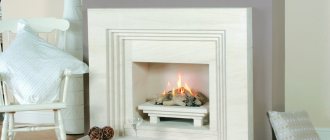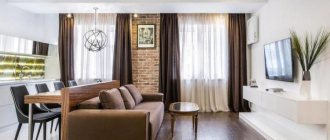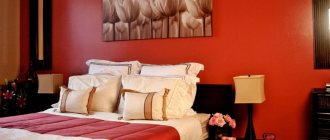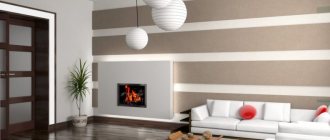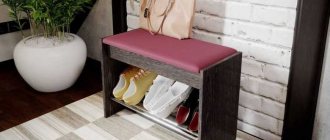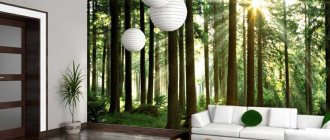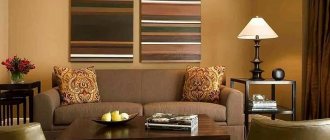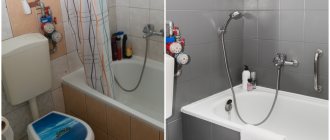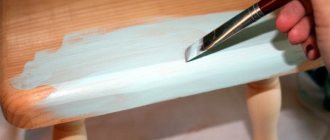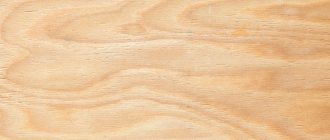Painting surfaces is not only the most economical finishing method, but also an opportunity to create a creative design in your home. To transform the interior, you don’t need to hire a team of workers; you can do the work yourself, and if you use your imagination, you can transform the house.
Preparing the walls
Painting the walls in an apartment is easy to do with your own hands. The painting technology itself is quite simple, but the result will please you only with high-quality surface preparation. If wallpaper can hide minor imperfections and defects, then paint, especially matte, will only highlight them. Only textured materials can hide pits and small irregularities, but ordinary paints cannot do this. The problems of the walls will be especially noticeable in good lighting: they will immediately catch the eye.
To prepare the walls for decorative finishing, you need to do the following:
- clean the base from the old coating, especially from smooth paints;
- repair all defects and putty if necessary;
- sand the walls well;
- apply primer in 2-3 layers.
You can start painting only when all layers of the rough finish are completely dry, otherwise the paint will apply unevenly and will not last long.
Using stencils
The stencil method allows you to decorate walls with designs of varying complexity, regardless of artistic abilities. You can create even a very complex pattern just by purchasing the appropriate stencil.
And it will take much less time to create a drawing using a stencil than with hand painting. The range of drawings obtained by this method is very wide: flowers, trees, animals, insects, abstraction, and the list goes on.
For inspiration with this painting method, we offer a master class on creating a floral ornament.
Master class: Floral print
To somehow diversify the walls and not leave them just white, decorate them with a contrasting floral pattern created using stencils.
To do this you will need the following materials:
- Stencil
- Paint (white for the background and contrasting, in this case bluish with a tint, for the drawing)
- Brush (a small one with short, stiff bristles is best)
- Painting tape (only for attaching the stencil to the wall while you work, and not asking someone to hold it)
Progress:
- Clear the room by providing a comfortable approach to the wall. Apply white paint, thus creating a field for the drawing. Wait until it dries.
- Place the stencil on the wall and secure it with masking tape. It must be well fixed, since if it slides after painting begins, it will be difficult to return it exactly to its previous place.
- Dip the brush into the paint, then shake it out thoroughly or wipe it a little with a towel so that the paint does not drip, otherwise it may flow under the stencil and the design will be ruined. The brush should be almost dry. Start sketching the stencil.
Important: When painting, carefully watch your free hand so as not to leave fingerprints with paint on the white wall.
- When the stencil is drawn and the paint has dried, move it to the next place and repeat the previous steps. Continue until you have covered the entire wall.
- When the last paint has dried, place the furniture in place and enjoy the created design.
Types of paint
Interesting ideas for decorating walls can be done using a variety of paints. There are several types of materials on sale that are suitable for indoor walls and have a rich color palette. The properties of paints vary depending on their composition.
Acrylic paints
Such materials are most often used in finishing work, since they have the best price-quality ratio and a large assortment of shades for tinting (about 1000 tones). Acrylic paints are fireproof, do not harm health and the environment, and strengthen walls. Finishing with such material will last a long time, because it will not be subject to destruction from temperature changes. You should not use acrylic paints in very humid rooms: they are not highly moisture resistant.
Latex paints
Typically, such materials are purchased for rooms with high humidity. After application, they form a durable protective film that protects the walls from water and damage. Latex paints are environmentally friendly, odorless, fireproof, and dry quickly. When thickened, they can be diluted with water. Unfortunately, the color range of such materials is less extensive; they are usually tinted in soft colors. Harmful microorganisms (molds) can multiply under the film, so it is advisable to apply a primer with antiseptic additives to the walls before painting.
Water-based paints
These materials have the lowest cost, are completely harmless, are breathable, and do not disturb the indoor microclimate. They are considered the most popular for painting walls because they are economical in consumption, are sold everywhere and can be tinted in any color. The downside is the need for frequent renewal, the speed of rinsing.
Alkyd and oil paints
Alkyd paints produce bright, rich colors, they are very durable, not susceptible to scratches, are suitable even for wet rooms, and serve for a long time. The paints have a significant drawback: they are harmful to health until they dry completely, as they contain toxic organic solvents.
Oil paints are now practically not used in interior finishing work. They take a very long time to dry, give an unnatural-looking coating, have huge consumption and high cost.
Silicone paint
This material is well suited for walls with slight unevenness. It is able to fill small cracks and holes, visually leveling the surface and giving it an attractive appearance. Silicone-based paints prevent the growth of fungi and have excellent water-repellent properties. The downside is the high cost of paints, which is why they are used less often in decoration than acrylic and water-based paints.
Silicate paint
These materials contain pigments and liquid glass. They are perfect for concrete, plastered walls in dry rooms; they are not used in conditions of high humidity and unstable temperature conditions. Silicate paints are fireproof, have a high degree of vapor permeability, and their coating will withstand more than 10 years of operation.
Acrylic-vinyl paint
The composition contains acrylic dispersion and polyvinyl acetate, which is the basis of PVA glue. The paint is considered budget-friendly and is widely used for interior decoration. The material has quite a lot of disadvantages. It does not belong to the category of wear-resistant coatings, does not tolerate humidity and temperature changes, and requires perfectly smooth walls, otherwise all defects will be visible on them.
Acrylic latex paint
By adding latex, this acrylic paint becomes more beautiful, matte, and allows you to obtain a durable coating that is resistant to moisture. The material is characterized by high decorative and performance qualities.
Structural paint
This paintwork material is characterized by increased viscosity and the presence of special particles in its composition, which allows it to give the wall an unusual texture. The paint can be acrylic, silicone or mineral based. It is non-toxic, odorless, has excellent water resistance, and the painted coating can be washed with SMS.
The material masks base defects, lasts a very long time, allows you to make an original drawing on the wall and show your imagination. The paint is applied with a sponge, a hard textured roller with teeth, a special comb or a spatula. Disadvantages - high price and the need for certain work skills.
Stages of applying decorative coating
To work, you will need a brush with natural bristles, a spatula, a scraper, a foam roller, a container for the roller, and a wet cloth to remove drips.
When preparing the surface for painting, uneven surfaces are smoothed out using a spatula, and sagging and drips are removed with a metal scraper. Cracks, chips, potholes are carefully sealed with cement mortar, alabaster, and after drying, the areas are treated with sandpaper.
- Sockets, switches, lighting fixtures must be removed and wires insulated.
- Cover the prepared and even surface with a primer, the shade of which matches the color of the paint.
- Painting begins with hard-to-reach places, corners, sockets, batteries. These areas are carefully passed with a brush.
- A flat section of the wall is painted with a roller or spray gun. After applying the base layer, after it dries, re-painting is carried out.
Paints with organic fillers, textured and decorative ones must be thoroughly mixed, as the fillers settle to the bottom. When painting large spaces, use a construction mixer.
Among the variety of paints and varnishes, preference should be given to trusted manufacturers. Among the sales leaders on the European market is the Tikkurila brand.
Tikkurila interior paint is of high quality and affordable prices.
Advantages of decorative paints
Using paints as decoration for residential premises has a lot of advantages:
- high service life when compared with wallpaper or different types of plaster;
- absence of joints, cracks, creation of a perfectly smooth coating;
- a large assortment of colors, shades, the ability to choose any desired tone;
- moisture resistance (for some paints), they are even used in the kitchen and bathroom;
- no need to clean the paint layer if you want to change the color (repeated applications over the old coating are possible);
- environmentally friendly, safe, they are used in children's rooms, in residential areas for allergy sufferers and those suffering from lung diseases;
- Suitable for all types of substrates: concrete, brick, plaster, plasterboard.
Painting walls in an apartment: design techniques
The easiest way is to paint the wall entirely in one color, but this method may seem boring. It is better to choose a fashionable designer coloring option, because a huge number of such techniques have been developed.
Textured coloring
This finishing method combines various methods of decorating one surface. The result is a coating with a unique texture and interesting shades. Due to the different arrangement of strokes and the overlay of tones, it is possible to mask minor defects in the base, which will reduce the time for its preparation.
Frottage
No special experience is required to implement this technique. First, you need to paint a section of the wall, then, before the paint is completely dry, take a piece of paper or cellophane, make a lump out of it and blot the wall. You can make regular prints or ones that overlap each other. For frottage, you should choose thick paints that dry longer and the prints on them will be more obvious.
Sponging
This is another way to create a textured surface. In this case, thick paint is applied with a sponge or brush, resulting in an interesting texture. It is best to choose water-based paints in pastel colors to visually increase the dimensions of the room.
Using a fabric roller
You can buy a fabric roller or make it yourself: wrap a regular tool in a lint-free cloth in the form of a rope. By taking coarse textiles, you can get an interesting effect that looks especially beautiful in a child’s room or bedroom. The procedure will be as follows:
- paint the walls in a neutral tone;
- wait for it to dry;
- prepare paint of a different, darker shade;
- moisten the rope on the roller with paint;
- paint the walls in different directions at once.
Ornament
You can make the ornament on any wall that has already been painted in the base color. First, you should draw it with a pencil, then paint it over with other paints with a brush.
Color combination
To paint the walls, you can use 2 colors or more - if desired. The main thing is that they harmonize well with each other, so it is better to test the painting in advance on paper. To visually raise the ceiling, darker colors are applied to the lower part, and the top of the walls is decorated with light colors. It is better not to use paint that is too dark: it will irritate and depress a person.
Gradient and ombre
Gradient is an interesting coloring technique that uses different shades of the same color. You should start from the bottom, taking darker tones. The gradient can use 3 or more colors, if desired. Ombre is a technique similar to a gradient, only the shades here smoothly transition into each other from saturated to light.
Borders
To combine different colors when painting, you don’t have to be a professional painter or artist. To obtain even borders, lay a strip of tape in the desired direction, and after the paint has dried, remove it. You can also make the boundaries clearer and more distinct with the help of slats, borders, moldings, beams, and mosaics. These same devices will help hide ready-made joints that are uneven.
Stippling
This method involves painting walls with the effect of an old, shabby surface. First, the wall is covered with the chosen paint, then a contrasting colored glaze is applied on top and randomly brushed over it with a wide brush. Additionally, you can touch the wall with a round paint brush while the glaze layer is still wet. As a result, the coating will look like an old one.
Skin effect
Typically this method is used in the office and hall. After painting, it will appear that the wall is covered with leather. To apply the paint you will need a suede brush and a piece of suede. The order of work is as follows:
- cover the base with latex paint of any color;
- separately mix darker latex paint and glaze;
- apply the mixture with a regular brush to a certain area of the wall;
- wet the suede brush with water, squeeze it out, and lightly touch the base, making streaks;
- apply a piece of damp suede to the area - this will help leave a “leather” pattern;
- Treat the entire wall in small parts in this way.
Venetian plaster effect
This method gives an excellent effect, however, it requires a serious investment of time. You need to pour latex paint into a large container and sprinkle a little dry pigment on one side. Next, you need to mix the pigment in only ½ of the mass so that the rest remains light. Then take light paint on a plastic spatula and apply it like plaster. Make a dark stroke nearby. After the appearance of multiple dark and light spots, you need to move the spatula along the wall to obtain a coating with streaks. As the paint dries, it is sanded with fine sandpaper and coated with a special wax composition.
Horizontal division
This technique visually expands the room. It involves the use of a horizontal dividing strip. It is best to decorate the bottom of the wall in a darker tone, and the top in a light tone, although various experiments are possible. A border is placed between different shades of paint.
Horizontal and vertical stripes
Narrow vertical stripes on the walls are especially recommended if the ceilings in the house are low. It is better not to overuse bright colors in this technique. It is very important to choose well-combined shades, otherwise the room will seem pretentious. You can also paint several horizontal stripes on the walls, which will visually expand the boundaries of the space.
Stencils
The use of stencils allows you to obtain original designs and ornaments even without artistic abilities. Templates are sold in stores, or you can make them yourself by printing or drawing. Afterwards, the stencil is fixed in the desired place on the wall, glued with masking tape and the central elements are painted in the required color or different shades.
Divorces
Making stains is as easy as shelling pears - to do this, you just need to randomly move a paint brush over a still wet wall on which paint of the required color has been applied.
Removing old coating
The easiest way would be to get rid of the wallpaper. It will be enough to pick them up around the corner and tear them off. Those parts that remain on the wall will need to be wetted and, after limpness, pryed off with a spatula.
It is more difficult with painted walls. Especially if it is an old “Soviet” oil paint, which does not adhere to water-based paints. To get rid of it, follow the advice of professionals:
If the paint begins to peel, remove it. You can first tap the wall; in those places where you hear a dull sound, there are voids and the paint will sooner or later fall out along with the new coating. It must be pryed off and removed.
Oil-based paint can be removed using a special solvent or after heating with a hair dryer. If the paint holds tightly, it will be enough to sand it with sandpaper and prime it.
Which color and style to choose
In order for the room to evoke only pleasant emotions after painting, you need to choose the right colors or their combinations. It is better to strive for your own desires, rather than follow fashion, because it changes almost every year. Here are the most popular paint colors and their purposes:
- white - ideal for ceilings, small rooms, visually expands the boundaries;
- beige is a very popular color, suitable for all types of interiors, looks better in combination with contrasting tones;
- black - reduces space, is used only as an accent, otherwise it will make the room gloomy;
- gray – looks stylish, gives coziness, can become a background for walls, but definitely requires dilution with more “cheerful” tones;
- red is an aggressive color, used in interiors with caution, practically not used in bedrooms and children’s rooms;
- yellow is an excellent color for creating bright spots and diluting a boring environment, especially recommended for northern rooms;
- orange – gives a feeling of warmth, harmony, encourages communication, is popular in the living room and kitchen;
- brown is a classic color in the interior; beige and peach shades go well with it;
- blue – gives a feeling of relaxation, calm, sets the mood for relaxation, its light shades are well suited for the bedroom;
- purple - used accentuated, as in the dark version it can cause a feeling of fatigue;
- green – calms, gives a feeling of closeness to nature, suitable for the living room, bedroom.
Room decoration styles may vary. Depending on the style direction, it is worth choosing both the shade option and the type of wall painting. Here are the most popular interior styles:
- Modern. Usually walls are painted in one or two shades; a popular combination of rich tones with white and beige colors is popular. Stripes and ornaments on the walls work well. The palette should be unobtrusive.
- Minimalism. Plain coloring is used in colors such as blue, gray, white. Textured paints and moldings are used.
- Loft. Typically the design includes brown, gray, black tones. Often a wall painted “like brick” is introduced.
- Classic. The interior can be decorated in any color, preferably pastel colors with ornaments, monograms, and gilding.
- Provence. Blue, lilac, mint tones, pink and peach shades are used. The walls can be plain or striped; artistic painting is popular.
- Country. Stone textures, mustard, white, brown tones, antique effects and whitewash are used.
Modern wall painting ideas
Interesting design techniques for painting walls can be introduced into the interior of any room: from the kitchen to the nursery.
Living room
This room can become a real platform for realizing creative ideas. The walls can be painted in several matching or contrasting tones, and different textured finishing materials are used.
Bedroom
The atmosphere here should be calm and peaceful. It is necessary to select only neutral, pleasing tones that are close to natural. It is better to avoid too rich shades. Stencils, stripes, various unpretentious ornaments, as well as an accent wall are well suited for bedroom design.
Kitchen
The kitchen uses paints that are easy to clean and have moisture-repellent properties. It is better to paint the walls in calm, discreet tones, and select the furniture in a contrasting color.
Children's
Drawings, stripes, numbers, other pictures, as well as areas made with slate paint look great in a child's room. They can be made bright, while the walls themselves are better painted in a neutral color.
Hallway
The corridor is often painted using ombre or gradient techniques, but too dark tones are not used here due to the lack of windows. You can combine painting with plaster or decorative stone. To visually expand the room, the method of horizontal stripes is used.
Bathroom and toilet
Wet rooms are painted only with water-resistant materials, but areas that will be regularly exposed to water are best tiled. Combinations of white with orange, blue, and yellow are traditional for the bathroom.
Balcony or loggia
Open balconies are painted with materials for exterior work, closed ones - with water-based emulsion, acrylic and latex paints with the addition of antiseptics. Most often, a cold palette of shades is used here to reduce the intensity of natural light.
Combination with other materials
It happens that in one room the paint is combined with other types of decoration. This helps make the design approach more creative.
Wallpaper and painting
Usually, only one accent wall is decorated with paint or wallpaper, and the others are finished with a second material. Some wallpapers can be used for painting, which will also serve as an interesting solution for a bedroom, office, or living room.
Photo wallpaper and painting
If one wall is covered with photo wallpaper, the rest can be painted. In this case, it is not recommended to use intricate painting techniques, since the photo panel already attracts enough attention.
Plastering and painting
Decorative plasters are covered with paint so that the walls are embossed and evenly colored. You can also combine “bark beetle”, other types of textured plasters and painted walls in the interior of a bathroom or hallway.
Wood and painting
Wooden walls trimmed with panels, lining, timber look good next to painting in the interior of country houses and attics.
Stone and painting
This combination is very typical for decorating the fireplace area, country style kitchen in the apron area. Also, the combination of stone and paint looks good in such style directions as Provence and loft.
Brick and concrete walls with painting
It is better to paint such surfaces with acrylic, latex, and alkyd paints. Artificial aging, drips, artistic strokes, and duets of contrasting colors look original.
Brick and paint
Usually the brick is red or white, less often colored. It can be coated with matching paint to enhance the brightness of the main shade or tinted in any suitable color.
3D panels and painting
Typically, such panels are used in modern interior styles. For them, a single color color is enough to make the design stylish, but not pretentious.
Drywall
Painting drywall is very popular. If you seal the joints well, the result will be perfect, because the walls and ceiling are smooth and have no flaws. You can use any, even the most complex, techniques on drywall.
What color?
One of the important steps, along with preparing the surface, is choosing the color for the living room.
In this matter, they often rely on their preferences, but one cannot help but take into account the features of the room and the intended interior. The living room is the face of the whole house. It is important to pay attention to the choice of colors. The shades are chosen so that you constantly want to return to this room and receive guests in it.
The choice of color depends on the following factors:
- Room size – in a small room it is best to paint the walls in light colors. This will visually expand the space. Suitable shades are beige, light gray, ivory. If the living room has a large area, you can experiment: make the walls more contrasting or with a soft transition.
- Lighting – this is an important factor, since the same shade can look different in natural and artificial light. They also take into account the side of the world on which the room is located.
- For the living room, located in the northern part of the house, warm shades (yellow, green, chocolate) are suitable. Painting these colors compensates for the small amount of sun.
- The southern room is painted in cooler colors: sky blue, white (how to paint a wall white?).
- A living room with windows facing east is best suited to warm light colors (for example, honey, peach).
- At the same time, for the western part it is better to choose cool shades (mint, gray, blue).
Advice
When choosing the color of the walls for the living room, you also need to take into account the design of the room and the colors of the furniture.
Expert tips for painting walls with your own hands
Before painting walls, you cannot ignore priming: only primer will help the paint lie flat, without spots or streaks. It is usually recommended to apply two layers of paintwork, so its consumption must be planned with a reserve. You can repaint the walls in colors close to each other or overlay pastel colors with richer ones.
When using a brush, you need to apply horizontal stripes, and then smear them vertically. The roller is rolled along the wall from top to bottom, pressing it well. The ideal option is to go over the layer with a brush and then rub it with a roller. Decorative painting is a real task, the main thing is to strictly follow the advice of the masters and plan the interior design in advance.
Photos in the interior of the rooms
Below you can see cool photo examples of a wall to be painted.
Read: How to make a wall-mounted key holder with your own hands: instructions and options for stylish ideas in hallway design
Let's discuss this article together:
Click to cancel reply.
